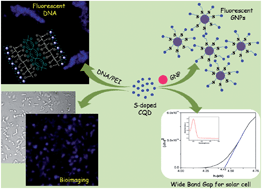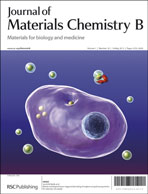Luminescent S-doped carbon dots: an emergent architecture for multimodal applications†
Abstract
A facile route has been developed to synthesise and isolate sulphur doped fluorescent carbon dots for the first time. Such carbogenic quantum dots exhibit a wide band gap of 4.43 eV with a high open circuit voltage (VOC) of 617 mV along with a fill factor (FF) as high as 37%, using phenyl-C60-butyric acid methyl ester (PCBM) as the electron transporting layer. Besides the wide band gap, which is useful in the fabrication of solar cells, sulphur modified carbon dots also exhibit a high fluorescence quantum yield of 11.8% without any additional surface passivation, producing a unique fluorescent probe for further applications. In addition, the particles have a strong tendency to interact with the surface of gold nanoparticles and produce a thin fluorescent layer over their surfaces. Moreover, as they are completely biocompatible in nature, the highly fluorescent S-doped carbon dots have a strong potential for use in bioimaging applications. Interestingly, owing to the presence of oxygen and sulphur functionality, the highly negatively charged particles can easily bind with positively charged DNA–PEI complexes, simply by mixing them, and after interaction with DNA, bright blue fluorescence has been observed under an excitation wavelength of 405 nm .

- This article is part of the themed collections: 10th Anniversary: Dedicated Authors and 10th Anniversary: Most popular articles

 Please wait while we load your content...
Please wait while we load your content...